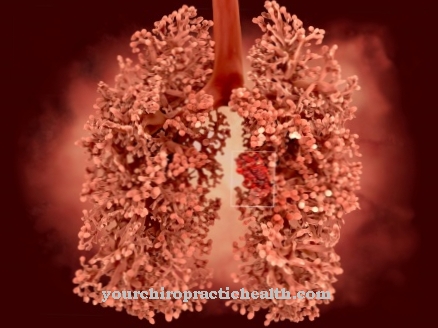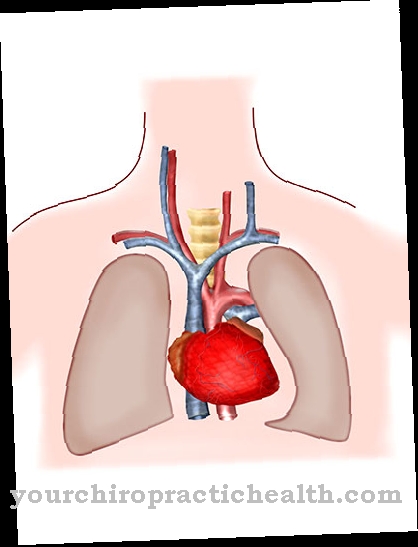Various negative influences from the environment have been shown to lead to diseases that can lead to tissue death. For example, a so-called gangrene entail.
What is gangrene?

© Neokryuger - stock.adobe.com
Gangrene is a disease that is assigned to coagulation necrosis. This means that there is insufficient blood flow, which triggers tissue death.
The gangrene is externally visible because the skin is predominantly affected. It can take a relatively long time for a pronounced gangrene to develop.
Gangrene can appear as a dry or wet disease. So-called wet gangrene is also known as foulburn and can be expressed, for example, in a leg ulcer.
causes
Various causalities play an important role in gangrene. The final tissue death occurs in particular due to the lack of blood flow in the poorly supplied areas. This means that in gangrene, the skin can no longer be supplied with oxygen and nutrients. A blockage of the blood flow occurs through injuries of the blood vessels, bacterial infections or constriction of the blood flow through swelling of individual organ areas.
Special diseases such as diabetes mellitus, physical overweight, obesity, alcohol addiction, tumors, peripheral arterial occlusive disease and HIV or AIDS can also lead to gangrene. An unhealthy lifestyle with associated drug use and smoking as well as advanced age also favor gangrene.
After treatment of cancer with radioactive rays or chemotherapy, the sequelae can be dry or wet gangrene. If there is extreme malnutrition with a deficiency in proteins and vitamins, the likelihood of gangrene is quite high.
Symptoms, ailments & signs
Gangrene has several stages. A damp gangrene initially causes redness, swelling and inflammation of the skin, usually accompanied by severe pain and a feeling of foreign bodies in the skin area. The moist form manifests itself as black discolored pus blisters, which are surrounded by thin, brittle skin.
If not treated, the gangrene can lead to blood poisoning, which manifests itself in the affected area as fever, malaise and severe pain. With dry gangrene, furry spots develop on the feet. The epidermis is usually covered by a cornea, which feels cold and rough to the touch. Dry gangrene can develop into wet gangrene as the disease progresses.
In the final stages of the disease, the skin turns dark and eventually dies. The pain that initially occurs is reduced and the affected area appears paralyzed and cold. Possible accompanying symptoms of gangrene are cold and colorless feet, dead areas on the toes, and skin ulcers. Damp gangrene can cause inflammation and itching. The dry form is usually very itchy, later the gangrene flakes.
Diagnosis & course
The gangrene runs in several stages until the final tissue necrosis, i.e. the death of the cells. This is seen as an advantage in medicine. This is because an adequate early detection and treatment of the gangrene can be initiated.
With wet gangrene, redness, swelling and inflammation occur. These are usually associated with severe pain. In this gangrene, black-colored, pus-filled blisters and a parchment-like skin are classic abnormalities. The wet gangrene can lead to blood poisoning.
With dry gangrene, patients complain of a cold and furry sensation in their feet. The epidermis is cornified. When feeling the pulse in the area of a gangrene, this cannot be perceived. There is a risk that dry gangrene will turn into wet gangrene. In the terminal stages of gangrene, the skin is dead and turns black. There is no more pain.
For the diagnosis of gangrene, skin ulcers, dead zones on the toes and colorless and cool feet are important. For wet gangrene, a smear may be subjected to a microbiological examination to clarify.
Complications
The gangrene causes discomfort to the skin. The skin is relatively dry and has red spots. The spots are usually itchy and swollen. Pressure pain also occurs and, in rare cases, pain at rest also occurs. As the disease progresses, the spots on the skin change color and take on a dark color.
In the worst case, the gangrene can get bacteria and viruses into the patient's bloodstream. This can lead to blood poisoning, which in the worst case can lead to death if it is not treated immediately. Other organs can also be damaged and infected by the gangrene. If it has spread significantly, the affected part of the body may have to be amputated.
As a rule, this results in considerable restrictions on movement for the patient. In harmless cases, treatment is carried out with the help of antibiotics. Small areas can be surgically removed so that there are no further symptoms as long as the infection does not spread any further.
When should you go to the doctor?
A doctor's visit is necessary as soon as circulatory disorders occur repeatedly or persistently. If the feet or hands cool down unusually quickly, this is an unusual health condition that should be checked. A doctor should be consulted in the event of numbness on the skin, sensory disorders or hypersensitivity to temperature or contact influences. If there is swelling or ulceration on the skin, a doctor's visit is necessary.
Redness of the skin or other discolorations should be clarified, as persistent skin changes can hide a health hazard. If open wounds develop that cannot be treated sterile, medical help should be sought. If the wound becomes infected, fluid leaks, or does not heal quickly, a doctor is needed. If pain occurs, a doctor must be consulted before taking any pain medication. If existing symptoms spread or if they intensify, a doctor is also required.
If the affected person complains of a burning sensation on the skin or develops pus, it is necessary to get medical care. If you have colorless limbs or pale skin, it is advisable to report your observations to a doctor. If the person concerned suffers a diffuse feeling of illness or malaise, he should also contact a doctor.
Doctors & therapists in your area
Treatments & Therapy
The treatment of gangrene includes a professional adjustment of the blood sugar level, the achievement of a normal blood lipid level and body weight.
Smokers must be denied nicotine and alcohol consumption if they have gangrene. Blood pressure should be lowered to a healthy level in gangrene. Gangrene or diabetic foot will only be treated by trained personnel.
Dead tissue is surgically removed. If the course of the gangrene is unfavorable, it can happen that either individual toes, the foot or the entire lower leg have to be amputated.
Outlook & forecast
The prospect and prognosis of a complete cure in an existing gangrene is highly dependent on whether medical and drug treatment is in place. Gangrene is a tissue breakdown that should be treated with medication and medication. Otherwise, the tissue will degrade over time, which can lead to serious inflammation. If the affected person decides on appropriate treatment, then a prompt and complete recovery can be guaranteed.
Anti-inflammatory drugs can effectively counteract the death of skin cells. Within a few days you should see a clear and visible improvement. The course of the disease is different if the person concerned completely dispenses with such treatment.
Gangrene can spread and worsen significantly in a very short time, so a visit to the doctor is essential. In order to improve the overall course of the disease considerably, the doctor should be consulted. Proper treatment can lead to smooth healing. A doctor should be consulted as soon as possible at the first signs of complications.
prevention
The prevention of gangrene is especially important for high-risk patients. In addition, healthy people must also expect gangrene.
Risk factors such as smoking and being very overweight should be eliminated. Therefore, the focus is on reducing obesity, more physical activity and a reduction in nicotine intake. Regular checks of blood lipid levels and the correct setting of blood sugar are particularly important for diabetics. Diabetics should only have their feet treated by trained podiatrists.
In addition, healthy, comfortable and possibly even footwear can prevent gangrene from developing. Pressure points on the feet, redness and swelling of the skin should be carefully observed. If there is inflammation, it is essential to have it assessed by a dermatologist in order to prevent gangrene.
Aftercare
Gangrene should always be treated by a doctor. As a rule, the patient cannot heal independently, although the options for follow-up care are severely limited in many cases. This can lead to severe complications if the gangrene is recognized or treated late, so that an early diagnosis with early treatment is the main focus.
If the gangrene is left untreated, it can, in the worst case, lead to death. As a rule, they are dependent on the intake of medication. It is important to ensure that the medication is taken regularly and correctly, and a doctor should always be consulted in cases of doubt or if anything is unclear.
A healthy diet together with a healthy lifestyle can also have a positive effect on the further course of this disease. In serious cases, however, those affected depend on the amputation of the affected limb, so that they need the help and support of friends and family in their everyday life. In some cases, it is also very helpful to get in touch with other affected persons.
You can do that yourself
In the case of an existing gangrene, an early visit to the doctor is very important and important for the later healing process. Nevertheless, affected persons can take their own measures for improvement and relief.
If gangrene is still in its early stages, certain foods can significantly support the healing process. Vegetables and fruits promote healing immensely, as they bring important nutrients to the body. However, white flour products, pork and sweets should be avoided entirely. Lymph drainage, which you can put on yourself, also support the entire healing process. The blood circulation in the respective body region is clearly stimulated and promoted.
If the gangrene is already at an advanced stage, the supply of vitamin A, vitamin E and bromelain is very important. These nutrients help to build up healthy skin and also support the removal of damaged or dead skin. Anyone who wants to counteract existing wound healing can use arnica drops or marigolds. Of course, strict cleanliness and hygiene should also be observed with gangrene. Without inflammation occurring, the tissue can heal in peace and the recovery time is shortened considerably.



























